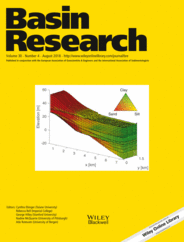
Full text loading...
 , Ivar Midtkandal1, Mark J. Mulrooney1,2, Tyler R. Appleyard2, Beyene Girma Haile1
, Ivar Midtkandal1, Mark J. Mulrooney1,2, Tyler R. Appleyard2, Beyene Girma Haile1 , Anna E. van Yperen1
, Anna E. van Yperen1
Investigations of syn‐sedimentary growth faults in the Last Chance delta (Ferron Sandstone, Utah, USA) show that fault‐bounded half‐grabens arrested high amounts of sand in the mouth bar and/or distributary channel areas. Fault‐controlled morphology causes changes in routing of the delta top to delta front drainage towards the long axis of half‐grabens. Faulting was spatially and temporally non‐systematic, and polyphase, with 3D cusp/listric fault geometries instigated by linkage of variously oriented segments. Hanging wall rollover folds consisting of wedge‐shaped syn‐kinematic sand attest to rapid <1‐m slip increments on faults followed by mild erosion along crests of fault blocks and sedimentary infill of adjacent accommodation. Triangle‐zones in prodelta to delta front muds are located underneath steeper faults and interconnected rotated fault‐flats. Their geometry is that of antiformal stack duplexes, in an arrangement of low‐angle‐to‐bedding normal faults at the base, replaced by folded thrusts upwards. These faults show a brittle, frictional flow deformation mechanism ascribed to early compaction of mud. For syn‐kinematic sand, there is a change from general granular/hydroplastic flow in shear zones to later brittle failure and cataclasis, a transition instigated by precipitation of calcite cement. Extensional faulting in the Last Chance delta was likely controlled by gravity driven collapse towards the delta slope and prodelta, as is commonly observed in collapsing deltas. The trigger and driving mechanism is envisioned as localized loads from sand deposited within distributary channels/mouth bars and fault‐controlled basins along the delta top. A regional tilt and especially displacement of compacted mud below sand bodies towards less compacted muds also contributed to the faulting.

Article metrics loading...

Full text loading...
References


Data & Media loading...

